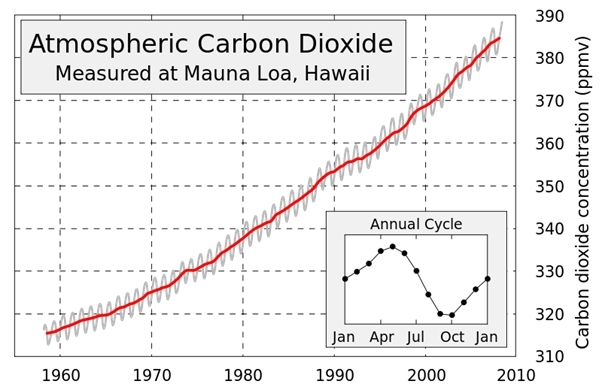What is climate change?
Climate change is the change in weather patterns that we can see on earth over a long time, for example hundreds to millions of years. Climate can change naturally because of changes caused by:
- volcanic eruptions
- meteor impacts
- ocean currents
- sunlight getting to the Earth
- sunlight leaving the Earth.
The climate has changed naturally on Earth many times. Colder periods are called Ice Ages but the Earth has also been warmer than it is now. Antarctica was once much warmer and trees grew.
How do you think weather is different from climate?
Changes caused by people
People have caused recent changes in climate by burning oil, gas and coal and by removing forest and farming. This has caused the levels of greenhouse gases in the air to grow. Greenhouse gases cause global warming by stopping heat from escaping back into space.
Can you find out how greenhouse gases are measured?
What are greenhouse gases?
Greenhouse gases are those that help cause the ‘greenhouse effect’. The most common greenhouse gases are:
- water vapour (water in its gas form)
- carbon dioxide
- methane.
What is the ‘greenhouse effect’?
The ‘greenhouse effect’ is what happens when the sun’s heat is trapped by greenhouse gases (in the way sun is trapped by glass in a glass house). This causes higher temperatures on Earth. One of the greenhouse gases, carbon dioxide, has increased very quickly since the beginning of the industrial revolution in 1750. This is when people started burning more fossil fuels (such as coal and oil). This increase in carbon dioxide can be seen on the graph below:

This increase in CO2 causes the man-made part of the greenhouse effect that has caused global warming. This climate change is happening much faster than natural climate changes that have happened in the past.
Why is this a useful way of displaying data about carbon dioxide and why do you think there is such a strong annual cycle?
Antarctica and climate change
In parts of Antarctica sea ice is melting more while in other parts it is increasing.
Antarctica can store heat affecting the climate of the whole Earth because;
- It has a large ice sheet which reflects heat.
- Most of Antarctica is high above sea level so cold air flows downwards from high ground.
- It is a long way south so not as much of the sun’s energy reaches the surface.
- There is less moisture in the air as it is locked up in ice sheets and sea ice.
- Saltier water forms around sea ice as salts drain out of freezing sea water. This saltier water is heavier so it sinks forming cold water deep down in the sea that spreads out under the world’s oceans.
Both the ice sheet and the sea ice are likely to change if temperatures keep getting warmer.
Changes in the total amount of ice are of great concern to scientists because of their impact on sea level. If an ice sheet is growing, it lowers sea level as water is stored as ice; if it is shrinking, it tends to raise sea level.
How high above sea level do you live?











